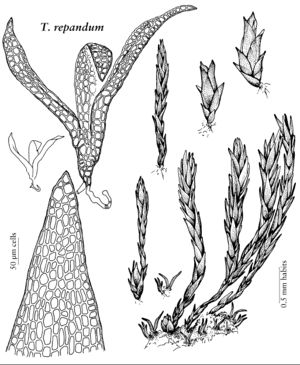Difference between revisions of "Tetrodontium repandum"
Sp. Musc. Frond. Suppl. 2(1,2): 102. 1824,.
Basionym: Tetraphis repanda Funck
Synonyms: Tetraphis brownianum var. repandum (Funck) Limpricht
Treatment appears in FNA Volume 27. Treatment on page 113.
FNA>Volume Importer |
FNA>Volume Importer |
||
| Line 49: | Line 49: | ||
|publication year= | |publication year= | ||
|special status= | |special status= | ||
| − | |source xml=https://jpend@bitbucket.org/aafc-mbb/fna-data-curation.git/src/ | + | |source xml=https://jpend@bitbucket.org/aafc-mbb/fna-data-curation.git/src/8f726806613d60c220dc4493de13607dd3150896/coarse_grained_fna_xml/V27/V27_132.xml |
|genus=Tetrodontium | |genus=Tetrodontium | ||
|species=Tetrodontium repandum | |species=Tetrodontium repandum | ||
Revision as of 16:53, 18 September 2019
Plants with numerous flagelliform shoots, these 2–5 mm with 3-ranked, tightly appressed linear to lanceolate leaves at the base of the stem. Thallose protonematal flaps ovate-lanceolate, without a distinct mucronate point, margins ± dentate, less than 0.5 mm. Leaves with costa absent. Spores about 16 µm.
Phenology: Capsules rare to very rare, maturing late summer.
Habitat: Often growing inverted under rock ledges or in crevices, especially in areas of high humidity sometimes mixed in with other bryophytes
Distribution

in North America it occurs in subalpine areas, B.C., Alaska, Wash., Europe, Asia (Japan).
Discussion
Selected References
None.
Lower Taxa
None.
